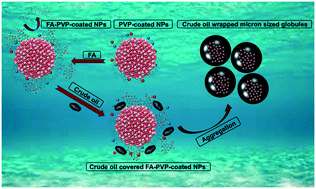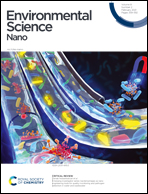Mechanistic study of oil adsorption onto PVP-coated magnetic nanoparticles: an integrated experimental and molecular dynamics study to inform remediation†
Abstract
Nanotechnology has recently sparked considerable interest as a cleanup technique for oil remediation. Although several studies have been reported in this area the mechanisms of the surface processes involved in the adsorption of oil onto nanoparticles (NPs) are still not clearly elucidated. Here, we combine molecular dynamics (MD) simulations and experimental data using ATR-FTIR spectroscopy to show that polyvinylpyrrolidone (PVP) polymer interacts physically with magnetite cluster via van der Waals with an average binding strength of −9.2 kcal mol−1. The results indicate that the adsorption of crude oil onto PVP-coated magnetic NPs is thermodynamically favorable with an adsorption free energy of −3.6 kcal mol−1. However, crude oil adsorption reduces in the presence of fulvic acid (FA), which is attributed to the ability of FA to partially displace PVP in seawater and form a new coating layer on the magnetite surface. Our work highlights the implications of molecular interactions and environmental conditions on the adsorption of crude oil onto NPs, which is critical for the effective design of nano-based oil remediation strategies.



 Please wait while we load your content...
Please wait while we load your content...